Historic Kentucky
Excerpt from James Archambeault's Lecture, January 26, 2007
About |
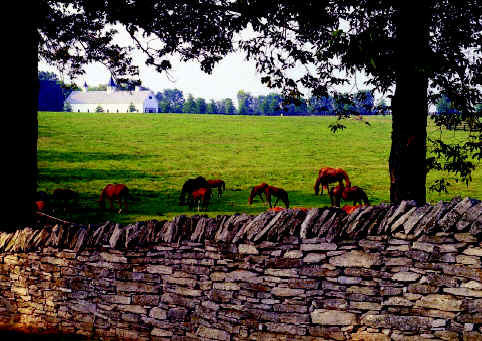 As a recent member of The Filson, I have little, direct knowledge of the actual
day-to-day work of the society. However, your reputation carries tremendous weight
as the preeminent private source of historical data in Kentucky and the region as a
whole. So, I feel somewhat inadequate, even intimated, standing before such a knowledgeable,
experienced and dedicated group of people.
As a recent member of The Filson, I have little, direct knowledge of the actual
day-to-day work of the society. However, your reputation carries tremendous weight
as the preeminent private source of historical data in Kentucky and the region as a
whole. So, I feel somewhat inadequate, even intimated, standing before such a knowledgeable,
experienced and dedicated group of people.
I hope therefore you will simply consider me an amateur historian and a sometime preservationist, who, through my work as a photographer, a chronicler of Kentucky, has, through some reading, but, mostly through experience learned and come to appreciate and embrace the history of this beautiful and sometimes perplexing place most of us call home. But however you may consider me, I feel that I represent the average citizen of Kentucky, because these are the people with whom I have been in contact with during the past 30 years.
My work as a nature and landscape photographer has taken me across this state many times. According to my mileage records, I can safely say that I have driven roughly a million miles in Kentucky. That translates into 40 times around the world. Except for perhaps a career state highway inspector, I have seen more of Kentucky than any person has or will probably ever see. I have met and talked with hundreds, if not thousands of Kentuckians in my journeys across the state. I’m talking about coal miners, shop owners, small farmers, tobacco cutters, horse stall cleaners, assembly line workers and well, I could go on. What I have found is that Kentuckians love Kentucky. Maybe its because their ancestors came here originally to be left alone and for the most part that is what is happening today.
The poorest people of Kentucky live on the fringe of the bureaucracy. They live in trailers and ram-shackle houses, up the hollows and on dead end roads where the state can’t find them. It’s my opinion that this state of affairs for the most part is perfectly all right with these citizens and that the state doesn’t want to find them anyway.
I want to lead into the next part of my talk by attempting to put into perspective the past 200 years, or roughly the length of time Kentucky has been a state. Two hundred years is nothing but the striking of a match in the history of the Earth, of mankind, of the brief history of a country called America. When I was born in 1943, the Civil War had been over a mere 78 years. Seventy-eight years, roughly the average lifetime of a person today. To put that time span in further perspective, World War II ended 62 years ago and we still relive it over and over as if it was yesterday.
In 1943, there were people still alive who fought in the Civil War, who remembered Antitem, Cold Harbor, Gettysburg and Perryville. They witnessed the horror of war and it still ached in their hearts as if it was yesterday, the army still held reunions at the battle sites, Confederate and Union veterans together, proud that they had fought and lived through a tumultuous period of our history.
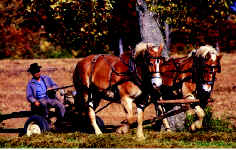 Now, 63 years later, the Civil War ended 141 years ago. The people
who fought in it are gone, but through historical research and reenactments,
we have found a way to get into the skin of soldiers, their wives
and children, and live it as they may have seen it. Witnesses to such
reenactments report being overwhelmed by the experience and having
gained a new awareness and respect for that period of our history and
history in general.
Now, 63 years later, the Civil War ended 141 years ago. The people
who fought in it are gone, but through historical research and reenactments,
we have found a way to get into the skin of soldiers, their wives
and children, and live it as they may have seen it. Witnesses to such
reenactments report being overwhelmed by the experience and having
gained a new awareness and respect for that period of our history and
history in general.
Like basketball, history is not just for professionals. It is available for everyone. If only professionals cared about history then we would have a lot of students failing history class, if anyone cared to sign up at all. We would not have thousands of restored historic sites and homes across America, we would not have tens of thousands of dedicated re-enactors.
To me, there are two kinds of history, the present, real-time history and past history that we experience through books and films. I always take the opportunity to bear witness to history as it is happening in my lifetime. Because it is an emotional, real-time experience, it stays with me like a good or a bad meal and I can always tell people that I was there. Some history is forced on every one of us whether we are interested in it or not. The greatest and most profound events of our own lifetimes need not be repeated here.
History is a living, breathing experience. In its highest state, it is a direct transformation, an emotional connection to the lives and events of the past. This is what I refer to as the fun of history. Do I believe in ghosts? No, because I’ve never seen one. But do I believe that one can feel the presence of past human beings with a power that almost takes one’s breath away — that one can have the experience of those people from the past and for a few brief moments breath with them the same air? In short, it is my belief, that direct experience of history can be the emotional trigger that leads to a life filled with love and respect for history and interest in historic preservation movements.
I doubt anyone in this room would deny that Kentucky is one of
the poorest educated states in America. One could argue that the failure
of the state to provide money for public education in its first constitution (in effect for more than 50 years) placed Kentucky at a disadvantage
from which it is still trying to recover. Let me say here that poorly
educated does not mean unintelligent or incapable. It simply means that
many people of this state have not been given the opportunity to expand
their intelligence, to find themselves. Or, if they have been given the
opportunity, many have chosen to reject it and trade it for instant
gratification through low-paying jobs. It is a choice that traps the individual
in a social and economic cycle from which there is little opportunity
for escape.
(in effect for more than 50 years) placed Kentucky at a disadvantage
from which it is still trying to recover. Let me say here that poorly
educated does not mean unintelligent or incapable. It simply means that
many people of this state have not been given the opportunity to expand
their intelligence, to find themselves. Or, if they have been given the
opportunity, many have chosen to reject it and trade it for instant
gratification through low-paying jobs. It is a choice that traps the individual
in a social and economic cycle from which there is little opportunity
for escape.
I don’t think that the vast majority of Kentuckians know about their own history. And if they don’t know about their own history, there is a little chance that they care a whit about preservation. Even if they do know about this state’s history, the vast majority of those still don’t involve themselves in historic issues. To me, the huge task for us is to enlighten all the citizens of our Commonwealth of the richness of our heritage and of the need to preserve that heritage. I hope for example that this book, a simple but direct presentation of Kentucky’s early history will reach many and perhaps create a spark that ignites further interest and exploration in history and historic preservation.
The people in this room don’t have to be convinced by my words. It is the people who are not in this room that need to be reached. That need is to be made aware of the importance of Kentucky’s unique heritage and of the real value of saving what we still have. If Kentucky’s citizenry do not realize that they’ve lost anything, then to them, nothing has been lost.
I want to quote from the preface of my Historic Kentucky book.
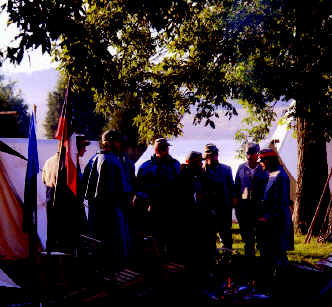 This book is a collection of photographs I have taken during the past 30
years. The images reflect on the passing of an era in Kentucky history and
what we, as a largely rural society, have preserved what we have lost and what
we are losing, While known historical sites take precedence, the photographs
attempt to depict a slice of the social and cultural heritage that Kentuckians
take for granted. From the Revolutionary War battle at Blue Licks to the last
general store at Far West Madrid Bend, the photographs are meant to evoke
a feeling for what Kentucky has meant to us as we begin a new century.
This book is a collection of photographs I have taken during the past 30
years. The images reflect on the passing of an era in Kentucky history and
what we, as a largely rural society, have preserved what we have lost and what
we are losing, While known historical sites take precedence, the photographs
attempt to depict a slice of the social and cultural heritage that Kentuckians
take for granted. From the Revolutionary War battle at Blue Licks to the last
general store at Far West Madrid Bend, the photographs are meant to evoke
a feeling for what Kentucky has meant to us as we begin a new century.
The idea for this book had been forming in my mind for many years. My interest in history was enhanced by my love of nature and the landscape. My first Kentucky books were dominated by natural areas and the environment. During this time, I began accumulating photographs of historical subjects that I perceived as disappearing. In the beginning, I was casual about stopping to photograph barns, old farmhouses and country stores. As late as 1975, many of these structures were still standing, if not still in use. In the mid — to late 1980s, I became more conscious of the patterns of extreme change in social and cultural traditions that were taking place across the Commonwealth. Locations that I had photographed only a few years before were gone. This realization gave a greater sense of urgency in recording these soon-to be- forgotten buildings and sites.
Because of your interest and dedication to history and historic preservation in Kentucky, I am sure that this great sense of urgency lives within all of you. Due to its long history of agrarian traditions, Kentucky is blessed with a treasure of artifacts. But unless these treasures are recognized, preserved and guarded, they will be lost forever. Sites are falling into decay or have been destroyed as I speak. Imagine how many original log cabins were bulldozed or allowed to remain only to be buried at the bottom of Lake Cumberland for example. Had we had the foresight, many of those structures could have been moved to other locations and preserved.
Part of the broader problem we have today is what I call rural
sprawl. The indiscriminate use of land has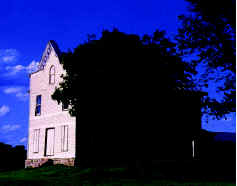 caused a chaotic pattern of
growth that is blighting the Kentucky landscape. While such uncontrolled
land use, like “pop-up” subdivisions and strip malls are routinely
approved by local governments for their tax benefits, old homes,
barns, schools and stores stagger and sway on their foundations, inevitably
falling down through neglect. Why maintain a once-stout barn
when there is no crop to put in it, no livestock needing shelter, no people who depend on the structure’s existence? Of course this
brings up the inevitable question of what is the economic
benefit in the cause of historical preservation? What value can
be placed on saving an old country store or rural church or
abandoned farmhouse? We here know the value of preserving
these structures and their symbolism to a past way of life, but
how do we pass this concern to our children and grandchildren,
who live in worlds of televisions and computers?
caused a chaotic pattern of
growth that is blighting the Kentucky landscape. While such uncontrolled
land use, like “pop-up” subdivisions and strip malls are routinely
approved by local governments for their tax benefits, old homes,
barns, schools and stores stagger and sway on their foundations, inevitably
falling down through neglect. Why maintain a once-stout barn
when there is no crop to put in it, no livestock needing shelter, no people who depend on the structure’s existence? Of course this
brings up the inevitable question of what is the economic
benefit in the cause of historical preservation? What value can
be placed on saving an old country store or rural church or
abandoned farmhouse? We here know the value of preserving
these structures and their symbolism to a past way of life, but
how do we pass this concern to our children and grandchildren,
who live in worlds of televisions and computers?
I don’t know the answer to this question, but I’m sure it is and has been endlessly discussed and debated. I do believe that part of the answer lies in combining historical preservation with tourism. It is already being done in this state and others and I believe could be expanded. For example, the creation of more historical highway trails, like the existing Bluegrass Scenic Byway concept or the Civil War Discovery Trail could preserve those areas and educate visitors as well as residents. Such trails could take in the small towns and rural crossroads of which Kentucky has so many. I would hope that we could encourage families to travel these trails and influence their children to embrace the history and tradition, which is their heritage.
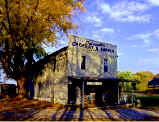 What about a program on a parallel with our “adopt a
highway” where individuals, companies and civic organizations
maintain a stretch of road by routinely picking up litter
and performing other small maintenance measures? Adopting an old building and caring for its structural integrity could save many
of these structures from disappearing and could form a destination on
a local historic highway trail.
What about a program on a parallel with our “adopt a
highway” where individuals, companies and civic organizations
maintain a stretch of road by routinely picking up litter
and performing other small maintenance measures? Adopting an old building and caring for its structural integrity could save many
of these structures from disappearing and could form a destination on
a local historic highway trail.
Today, the competition for minds and hearts is fierce. Are we ourselves in fact artifacts? Are we the last of a generation that cares about history and historic preservation? Can we against the incredible might and diversity of the new age of technology that temps us and glues us to computers and TV screens, convince even a small percentage of our children that the old stone silo down the road should somehow be preserved? Can such a passion be created when we are up against cell phones, I-pods, Nintendo and who knows what else tomorrow?
I believe it was the CEO of Cisco Systems, a highly respected software development company, who recently said that “unless we gain some assemblance of control over technological advances, we may be overwhelmed by them and that it may be our undoing”.
In closing I want to quote from my book the section of my essay entitled “Old Kentucky.
”If one is willing to search, remnants of old Kentucky can still be found.
It is most often seen and survives on the farthest back roads and along
county boundaries. However, Old Kentucky can thrive within sight of the interstate
or just over a hill or a few hundred yards down a country lane connecting
to a major highway. A set of county maps is a helpful tool. Sometimes
just “getting lost” works well, resulting in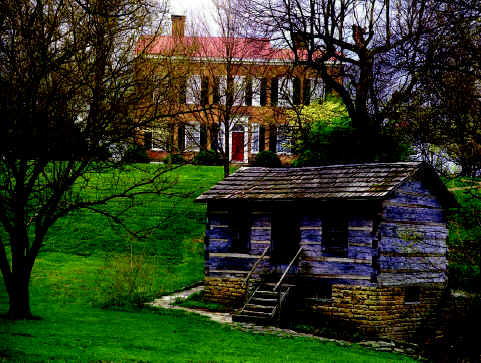 surprising finds.
surprising finds.
In many ways Kentucky has been a forgotten state, not for those who live here and know it, but to most who live outside its borders. One reason for this is the state’s geographical location, hemmed in on three sides by the natural physical barriers of the Mississippi River to the west, the Ohio River to the north and the Appalachian Mountains in the east. While modern day transportation improvements have broken down the effect of these barriers, the barriers, until recently influenced Kentucky’s place among the states.
Perhaps this has been, in some ways, a good thing. Due to history, geography and poor educational opportunity, many Kentuckians have been reluctant to enter the seemingly chaotic world around them. Through such unwillingness, we have involuntarily preserved old ways and traditions. In spite of our problems, Kentuckians are a proud people, perhaps the proudest of any state. Many people, who leave Kentucky for jobs or family, find their way back. And those who choose to live elsewhere never forget their Kentucky roots. Active Kentucky social clubs have been formed in some of the nation’s largest cities to nurture their own Kentucky expatriates. The majority of our citizens like living here, where lives are run at a slightly slower pace than in much of the rest of the United States. One can feel the change just crossing a bridge over the Ohio River from Cincinnati to northern Kentucky.
While the old traditions are quietly passing, they are bit being suddenly yanked away from us. In the simplest terms, the images we hold in our minds and the land we still cherish are ways for us to remember and invigorate our sprits. Kentuckians have been fortunate that many of our most significant historic sites and buildings have been preserved. This has been due to the untiring efforts of thousands of people, in both the government and private sectors, who have dedicated themselves to saving and maintaining our rich historical heritage. Most of these historical sites and structures are available to the public.
In addition to the highly visible places, thousands of older, private homes and structures and many smaller less-known historical properties have been saved and restored or maintained mainly through private efforts, sometimes assisted by government or private foundations. All of these past and present efforts are to be saluted and supported in the future.
Many of us, myself included, still revere the old ways. We frequently visit historical sites in Kentucky and elsewhere, seeking an emotional connection to a place or event. We still slow down when passing old country stores, looking for flickering signs of life. We cling to the memory of our own past experiences in Kentucky and of the experiences of Kentuckians gone before, and we regularly find time to take a long drive in the country where regeneration is waiting.
![]()
The Filson Historical Society
1310 South Third Street - Louisville, KY 40208
Phone: (502) 635-5083 Fax: (502) 635-5086
Hours
The Ferguson Mansion and Office
Monday - Friday: 9 am. - 5 pm.
Saturday and Sunday closed
Library
Monday - Friday: 9 am. - 5 pm.
Saturday: 9 am. - 12 noon
